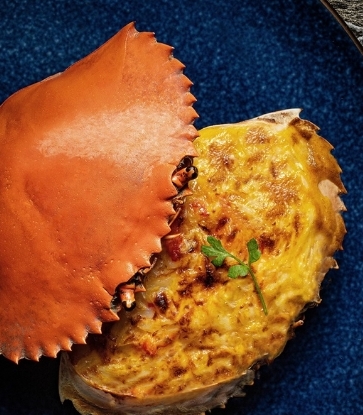The Lunar New Year is fast-approaching, and if you are in need of some wine pairing pointers for your upcoming feasts, you've come to the right place.
We asked sommeliers from MICHELIN-Starred restaurants in Hong Kong and Macau for wine pairing tips catered to three traditional Lunar New Year dishes: Poon Choi, Abalone, and Chinese Poached Chicken. Cheers!
Poon Choi: What to do when you have overflowing ingredients and flavours?
In recent years, poon choi (which literally means “basin cuisine”) has become an increasingly popular dish enjoyed during the Chinese New Year in Hong Kong and Macau. Easy to buy and prepare, this hearty dish packed with nostalgic flavours of home is perfect for Lunar New Year and other celebrations. The selection of ingredients is largely up to personal preference. Typically, ingredients that can withstand a longer cooking time are placed at the bottom such as preserved bean curd with lotus root, sweet radish, fragrant fried bean curd sheet, fluffy taro, and springy pork skin. Roast pork, roast duck, dace fish balls, shiitake mushrooms, prawns and dried oysters are often placed in the middle layer, with premium dried seafood ingredients — such as dried scallops, abalone, sea cucumber, and fish maw — placed at the top.RELATED: Is Walled Village Poon Choi A Disappearing Tradition?

Executive chef Kelvin Au Yeung of Jade Dragon, a three-MICHELIN-Starred restaurant in Macau, says, “A high-quality poon choi allows the unique flavours of each ingredient to shine. By combining the best of what these ingredients have to offer and elevating that with the abalone sauce — the soul of the dish — poon choi is the culmination of the finest with surprising depths of flavour.”
One might think that wine pairing would be challenging given the dish’s diverse flavours. However, City of Dreams’ head sommelier Joe Yang believes that since Chinese New Year is a time for family reunions, one can take a more relaxed approach with wine pairing. With the focus on celebration and a festive atmosphere, there’s no need to be constrained by conventional guidelines.
With all kinds of gourmet delicacies present in a poon choi, attempting to find one single perfect wine to complement all the flavours would be an overly ambitious endeavour. “My recommendation is a fruit-forward red with a rounded mouthfeel and refreshing aftertaste, such as a Marselan from China’s Ningxia or Xinjiang, or a Pinot Noir from Oregon, USA. These offer fresh fruit aromas and a richness that pair well with different kinds of meat. With lower tannins, they won’t overpower the delicate umami flavours of the seafood. The wines’ acidity can also help to cut through any oiliness from meats like roast pork and pork knuckle.” If the poon choi is served hot pot style, Yang has also offered the thoughtful suggestion of lightly chilling the red wine to enhance the fruity freshness and provide a crisper texture.
RELATED: Ask A Sommelier: How To Pick The Perfect Wine For A Cantonese Meal
“Since Chinese New Year is a time of family reunion, one can take a more relaxed approach with wine pairing.”
Just Wong is the Executive Director of Beverage Operations at Wynn Macau and Wynn Palace, who also oversees the beverage programs for two-MICHELIN-Starred Japanese restaurant Mizumi and two-MICHELIN-Starred Wing Lei. He agrees with a pairing of fruity wines and has recommended a rosé champagne of an older vintage: Laurent-Perrier Cuvée Alexandra Rosé 2004. Its pink hue and effervescence are perfect for celebratory occasions, while its high acidity and liveliness can counterbalance the gelatinous texture of collagen-rich sauces. He suggests using wide-mouth Champagne or Riesling wine glasses to allow the full expression of this vintage Champagne’s complex aromas, with the optimal serving temperature between 6 to 8°C.
Kenneth Tai, the sommelier of two-MICHELIN-Starred Rùn at The St. Regis Hong Kong, also recommends pairing poon choi with rosé champagne. His pick is the Champagne Minière F&R Influence Rosé NV, which offers a nose of red berries and a well-balanced tartness and sweetness that can complement the powerful and varied flavours of poon choi.
Over at MICHELIN-recommended hotel Mandarin Oriental Hong Kong, head sommelier Andrew Lam often pairs wine for the hotel’s one-MICHELIN-Star establishment Man Wah. Taking a more unusual approach, he believes Japanese sake can be a suitable match for poon choi. “Poon choi may contain a lot of ingredients, but they all have something in common: umami, which echoes with the umami flavour also found in sake. He recommends a full-bodied Jun-shu-style sake with a lingering sweetness of ripe bananas and cucumber, and the high level of amino acids can tease out the richness of meat and seafood.
If one has the time, sommelier Billy Yeung of MICHELIN-recommended hotel Grand Hyatt Hong Kong’s MICHELIN-Selected restaurant One Harbour Road suggests enjoying poon choi as a multi-course experience by pairing each layer of the dish with different wines. The top layer with chicken and shrimp can be paired with a Swiss Neuchatel white wine or a Germen Mosel sparkling wine; a red from Rhône in France or Ningxia in China would match well with the middle layer; and the bottom layer of the poon choi can be enjoyed with Vin Santo from Santorini in Greece or a natural white wine from Georgia. “Poon choi can take a long time to eat and the flavours are rather diverse. If there’s only one wine, the meal can become dull. Pairing this dish with different wines can be a fun experience and a great conversation starter among family and friends!”
RELATED: Ask The Experts: 11 Wine Grapes You Never Knew About

Abalone: Balance umami with fruity tartness
Yang remarks, “Most white wines may not stand up to such a thick sauce. I lean towards pairing the dish with an aged and refined red wine. Burgundy would be a sound choice, but aged Burgundy reds are not readily available; finding a good vintage that is in perfect condition may very well break the bank. So why not explore some interesting and more affordable alternatives? The neighbouring Beaujolais is home to many exceptional wineries. Their high-quality reds have a delicate and silky mouthfeel and are most likely from one of the ten grand crus in the region, such as Moulin-à-Vent and Fleurie. The wines’ ripe wild berry aromas unfold to reveal a richer complexity and depth. Younger vintages can be decanted for an hour or two for them to be fully expressive aromatically.”

Wong recommends the Chateau Rieussec R de Rieussec Blanc Sec 2. The white wine’s natural acidity and floral and honey aromas accentuate the abalone’s umami flavour. He suggests serving in a large white wine glass at 8 to 10°C to better release its aromas. Yeung, on the other hand, moves away from traditional wines and recommends a semi-dry Chinese Huadiao or Fino Sherry from Spain. These wines with a lighter body and natural savoury fragrance can enhance the abalone’s aroma and are worth a try.
Ricard Yim, Director of Operations at ZS Hospitality, the restaurant group behind two-MICHELIN-Starred Ying Jee Club and one-MICHELIN-Starred Whey, believes that abalone in oyster sauce should be matched with a white wine from Burgundy, such as an invigorating Chablis (his recommends the Jean-Paul & Benoit Droin Chablis Grand Cru Les Clos 2018), where its refreshing crispness can help cut through the unctuous sauce. “Apart from counterbalancing the richness, you can take the complete opposite route and intensify the flavours by pairing the dish with a spirit such as Cognac, which can really take the savoury umami of the oyster sauce to the next level!”
Chinese Poached Chicken: Match light flavours with a refreshing white
A light and refreshing white wine would be a suitable pairing for Chinese poached chicken. As simple cooking methods are used to highlight the chicken’s original flavour, it’s best to avoid wines that are overly fruity or have been aged in oak barrels for an extended period of time, or one risks jeopardising the effortless simplicity of the dish.
For Chinese poached chicken, Yang suggests a pairing of light and crisp dry whites, such as the Austrian Grüner Veltliner, or a Chenin Blanc from Loire Valley in France. Both wines exhibit high minerality and acidity, which flawlessly complement the chicken’s subtle sweetness. Younger vintages of these styles of white wine may present an overly sharp acidity upon opening, so double decanting (pouring the wine from the decanter back into the bottle) an hour before drinking can help to quickly release the aromas and ready the wine for an optimal tasting experience.
Wong’s pick is the Fei Tswei Viognier 2019, a white wine from Ningxia in China. This medium-bodied wine is floral and spicy with notes of vanilla and ginger lily, which pairs exceptionally well with Chinese poached chicken and ginger puree, and can accentuate the delicate fragrance of the chicken.
For Yeung, Chinese poached chicken goes well with sake or even gin and tonic. “Nowadays there are so many gins to choose from. You can simply add tonic water, which has the same refreshing quality as Chinese poached chicken. What’s more, bubbles always get people into the spirit of celebration!”
All photos courtesy of respective restaurants.
This article is written by Gloria Chung and translated by Iris Wong from its original Chinese version.




















